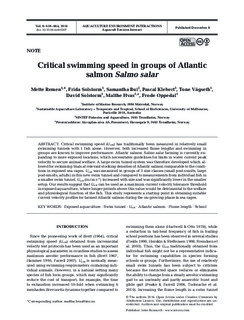| dc.contributor.author | Remen, Mette | |
| dc.contributor.author | Solstorm, Frida | |
| dc.contributor.author | Bui, Samantha | |
| dc.contributor.author | Pascal, Klebert | |
| dc.contributor.author | Vågseth, Tone | |
| dc.contributor.author | Solstorm, David | |
| dc.contributor.author | Hvas, Malthe | |
| dc.contributor.author | Oppedal, Frode | |
| dc.date.accessioned | 2017-09-05T16:05:47Z | |
| dc.date.available | 2017-09-05T16:05:47Z | |
| dc.date.created | 2017-01-24T13:25:24Z | |
| dc.date.issued | 2016-12-08 | |
| dc.identifier.citation | Aquaculture Environment Interactions. 2016, 8 659-664. | nb_NO |
| dc.identifier.issn | 1869-215X | |
| dc.identifier.uri | http://hdl.handle.net/11250/2453270 | |
| dc.description.abstract | Critical swimming speed (Ucrit) has traditionally been measured in relatively small swimming tunnels with 1 fish alone. However, both increased flume lengths and swimming in groups are known to improve performance. Atlantic salmon Salmo salar farming is currently expanding to more exposed locations, which necessitates guidelines for limits in water current peak velocity to secure animal welfare. A large swim tunnel system was therefore developed which allowed for swimming trials at relevant stocking densities of Atlantic salmon comparable to the conditions in exposed sea cages. Ucrit was measured in groups of 3 size classes (small post-smolts, large post-smolts, adults) in this new swim tunnel and compared to measurements from individual fish in a smaller swim tunnel. Ucrit (in cm s–1) increased with size and was significantly lower in the smaller setup. Our results suggest that Ucrit can be used as a maximum current velocity tolerance threshold in exposed aquaculture, where longer periods above this value would be detrimental to the welfare and physio logical function of the fish. This study represents a starting point in obtaining suitable current velocity profiles for farmed Atlantic salmon during the on-growing phase in sea cages. | nb_NO |
| dc.description.sponsorship | Norges forskningsråd | nb_NO |
| dc.language.iso | eng | nb_NO |
| dc.rights | Navngivelse-Ikkekommersiell-DelPåSammeVilkår 4.0 Internasjonal | * |
| dc.rights.uri | http://creativecommons.org/licenses/by-nc-sa/4.0/deed.no | * |
| dc.subject | Exposed aquaculture | nb_NO |
| dc.subject | Swim tunnel | nb_NO |
| dc.subject | U_crit | nb_NO |
| dc.subject | Flume length | nb_NO |
| dc.subject | Atlantic salmon | nb_NO |
| dc.subject | School | nb_NO |
| dc.title | Critical swimming speed in groups of Atlantic salmon Salmo salar | nb_NO |
| dc.type | Journal article | nb_NO |
| dc.type | Peer reviewed | nb_NO |
| dc.description.version | publishedVersion | nb_NO |
| dc.rights.holder | © The authors 2016 | nb_NO |
| dc.source.pagenumber | 659-664 | nb_NO |
| dc.source.volume | 8 | nb_NO |
| dc.source.journal | Aquaculture Environment Interactions | nb_NO |
| dc.identifier.doi | 10.3354/aei00207 | |
| dc.identifier.cristin | 1436566 | |
| dc.relation.project | Norges forskningsråd: 207116 | nb_NO |
| dc.relation.project | Norges forskningsråd: 841005 | nb_NO |
| dc.relation.project | Norges forskningsråd: 237790 | nb_NO |
| cristin.unitcode | 7566,3,0,0 | |
| cristin.unitname | Havbruksteknologi | |
| cristin.ispublished | true | |
| cristin.fulltext | original | |
| cristin.qualitycode | 1 | |

